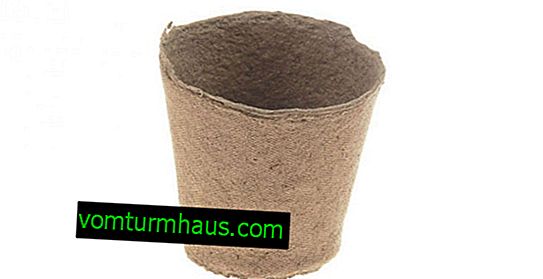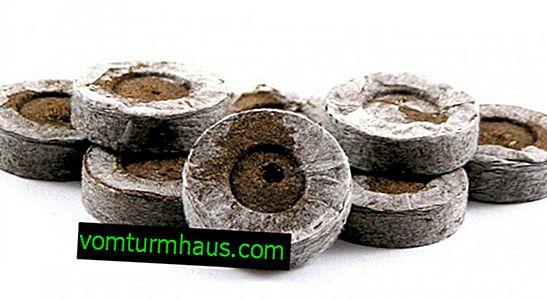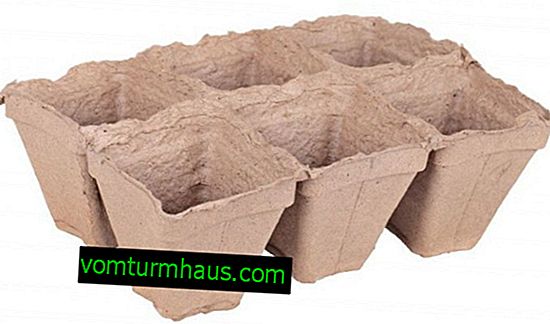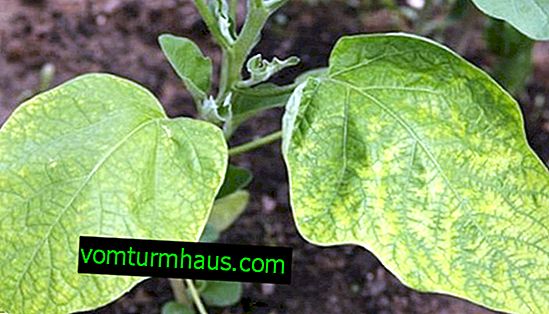Planting eggplant seedlings: growing and care
Growing high-quality eggplant seedlings at home is not possible for every grower. Even experienced gardeners sometimes fail - and all because they try to get healthy and strong plants by traditional methods of sowing seeds. Eggplant needs a special approach. Learn how to properly plant and grow seedlings of this crop, what are the agronomic subtleties and features of care.
Dates of sowing eggplant seedlings
Among all solanaceous eggplants, they occupy a special place because of their increased heat lovingness, exactingness to growing conditions and slow growth. This justifies the preference of the seedling method of their cultivation. Its success depends on the timeliness of planting grains, since overgrown stems will grow from the early crops, and weak and not adapted to replanting from the later ones.
Did you know? The ancient Greeks nicknamed eggplant "rabies apples", believing that their systematic use in food leads to clouding of the mind .
For the full development of eggplants, it is necessary to ensure a stable temperature regime at the level of + 22 ... + 25 ° С. If the thermometer column drops at least 2 degrees below the minimum values, pollination, ovary formation and bush growth will stop. When the seedlings are in an environment with a temperature below + 15 ° С, fruiting should not be expected at all, therefore, when planting eggplant seeds, it is important to take into account the climate and seasonal characteristics of a particular region.

Find out what to do if the leaves of the eggplant fade.
Given these characteristics, the best period for planting a plant is the end of February - the beginning of March. Adjustment of the indicated terms should be based on the fact that from the moment of sowing eggplant to transplanting seedlings to a permanent place, 2–2.5 months must pass.
Seed selection and preparation
Seeds of two years old are suitable for sowing - unlike annual seeds, they are characterized by high germination and short germination times. This is important to consider when preparing home planting material. Of the purchased grains, zoned samples that are well adapted to the climate of a particular area are preferred.
When buying seeds, experts advise:
- Give preference to high-yielding and resistant varieties with satisfactory keeping quality of fruits.
- Distinguish varieties from hybrids, since the purpose of growing a crop depends on this. If you want to get a quality crop, it will be appropriate to purchase hybrid grains labeled F1. However, hybrid selection retains the gene pool of parent plants only in the first offspring, so hybrids are not suitable for planting seeds for planting. Only varieties can be propagated on their own.
- Do not ignore modern agricultural achievements in this area . To improve the germination and preservation of grains in the soil, many manufacturers resort to pelleting, inlay, gel shell, tape, plasma structures. All these innovations are, to one degree or another, aimed at stimulating the viability of planting material and its resistance to various diseases.
- Pay attention to quality holograms and trust only trusted manufacturers.

Soil preparation and tank selection
Vegetable grows well in nutritious loose soil with neutral acidity.
To prepare such a light mixture you will need:
- garden chernozem substrate (1 hour);
- river sand (1 hour);
- vermiculite (1/3 h.);
- high peat (2 hours);
- humus or compost (1 hour).
Important! Shade from neighboring plants, a thickened planting and prolonged cloudy weather slow down the growth of eggplant. In such conditions, the crop will be scarce and small.
For growing seedlings, gardeners can use:
- Peat pots . Made from a porous material, they promote aeration of the roots of the plant, which is useful for its growth. Such products are filled with slightly moistened soil and seeds are planted in it. The grown seedlings do not dive, but are transplanted to a permanent place along with the tank. Advantages of this choice: environmental friendliness and nutritional value of the material, as well as a high percentage of survival of seedlings during transplantation. Excessive sensitivity of the peat pot to moisture can be considered a disadvantage - if the crops are overfilled, the walls of the tank will be covered with mold and infect the soil. But the soil should not be allowed to dry out, otherwise it will be petrified.

- Peat pills . They are compact fine peat with the addition of micronutrients, wrapped on the outside with a thin, durable mesh. There are different diameters: from 2.5 to 4.5 cm. Due to the tendency to swell, they are placed in a tray or in separate plastic cups, watered and, waiting for an increase in size by 5-6 times, they plant seeds. The advantages of tablets are the water and air permeability of the nutrient material, as well as the unhindered development of the root system. The flaw is the need to constantly monitor the moisture level in the crops.

- Peat cassettes . This planting capacity is similar to an egg tray of 70% peat and 30% cardboard. The grown seedlings are transplanted with the cell, separating it from the general section and completely deepening into the ground, otherwise it will cause dehydration of the roots of the seedling. The advantages of such containers are the additional nutrition that the culture receives when the material is dissolved, as well as the safety of the roots during transplantation. "Minus" - a tendency to quickly get wet and moldy.

- Polystyrene and polyvinyl chloride cassettes . The advantages of these portable nurseries are their availability, durability, lightness and compactness. In addition, the perforated base of the tank provides seedlings with an optimal water-air regime. Growing roots are laid in the form of a spiral and are not injured during transplantation, since they are easily untwisted. Plants grown in cassettes are always easy to take root. Polystyrene products are beneficial in the absence of toxic substances, but the chlorine present in PVC is dangerous to human health.

- Homemade wooden and plastic boxes . Their advantage can be considered a variety of structural sizes and material safety. Among the shortcomings are the need to dive seedlings and the risks of damage to the roots during transplantation, because in the total capacity fragile sprouts are often confused.

- Nurseries from improvised materials . These are all kinds of food containers from purchased products found in every kitchen. Their “plus” is transparency, which allows you to control the condition of crops, as well as a cover that provides a greenhouse effect. “Cons” are the small size and complexity of extracting seedlings during transplantation.

- Snails . These are original rolls from a film or other synthetic material laid by soft toilet paper. Seeds are sown not on a substrate, but on a paper base moistened with water, which is folded and placed in a deep container for germination. If desired, you can sprinkle it with a thin layer of peat-sand mixture. When the sprouts appear, they are transplanted into a separate container.

Technology for sowing eggplant seedlings
If the planting container is a container, the eggplant seeds are sown in a moist substrate. Initially, they fill the tank and moisten with a spray bottle. At this stage, it is advisable to use melt water, because a short-term cold will contribute to the development of vitality - thanks to this, the seedlings will grow strong and resistant to diseases. You can water the soil by covering it with snow, but this technology is acceptable only for non-sprouted seeds. If you plant grains with sprouts, the temperature of the earth should correspond to the range +25 ... + 27 ° С.
Important! So that the plants planted in the cassettes do not obscure each other, it is necessary to sow in a checkerboard pattern .
It is important to keep the distance between the seeds within 8–10 cm. It is better to sow in cassettes, distributing 1 seed per cell. The grains are deepened by 1.5 cm and covered with a layer of moist soil with a thickness of 0.5 cm. Then, the seeding is slightly compacted with palms and mulched to preserve moisture. At the final stage, the landing container is wrapped in polyethylene or covered with glass and placed in a well-lit dark place. After emergence, the container must be moved to the light.
Video: proper sowing of eggplant
Seedling Care
Knowledge about when and how to plant eggplant seedlings does not guarantee success in its cultivation, because care plays an important role here.
Did you know? Initially, European gardeners raised eggplants for therapeutic and decorative purposes, and only from the XVIII century began to eat their fruits.
Seedlings from the first days should be provided:
- Temperature mode . Initially, after removing the film, the container is put in a cool room for a week. At daytime temperature +16 ... + 17 ° С and nighttime +13 ... + 14 ° С root processes will begin to develop intensively. Then the tank must be transferred to heat, where during the day the level is maintained at +25 ... + 27 ° С, and at night - +13 ... + 14 ° С. It is important to pay attention to the difference in permissible day and night values - they are needed to simulate natural conditions and harden seedlings.
- Regular moderate watering . It is carried out to the extent necessary, avoiding either drying out or bogging of an earthen coma. All moisturizing procedures are best done using a spray gun, which will prevent the grains from leaching from the ground and exposing the roots. Preferred rainwater, or settled for 24 hours. It is important that it warms up to + 18 ... + 25 ° С.
- Good lighting . In the case of eggplant, fluorescent lamps will come to the aid of the gardener with 12-hour work - otherwise the stems will be very fragile and will stretch. The device should highlight the culture at a distance of half a meter, from about 7 a.m. to 7 p.m.
- Nutrients in the soil . If you notice a growth lag, seedlings will need additional nutrition. In containers that do not provide for picking, they are carried out one week after emergence, and in other cases 12 days after the picking. Initially, phosphorus fertilizers are useful for eggplants, which stimulate the development of rhizomes (a solution of "Crystal Yellow" in a proportion of 30 g per 10 liters of water). Subsequent feeding is carried out after 7-10 days with drugs that stimulate vegetation (Crystal Special, 30 g per 10 l of water).

Dates for planting seedlings
When 2-3 leaves are formed on the stems, seedlings need to be dived (if it grows in a common capacity). This period begins 4 weeks after sowing the seeds. Sprouts are carefully separated from each other, trying not to damage the roots. To do this, you need to prepare in advance individual pots, preferably peat, in order to avoid repeated injury to the seedlings when transplanting to a permanent place.
This is not required if seeding was initially carried out in individual cassette cells, tablets or containers. Eggplant seedlings are transplanted into a greenhouse or open ground in spring when the ground warms up and the risks of frost are passed. By this time, the seedlings will be about 50-70 days. The specific period is determined by the climatic characteristics of each region and the demanding culture.
Read also what to do if the eggplants in the greenhouse are not tied.
For example, in mid-latitudes it is better to transplant eggplant into greenhouse conditions in mid-May, and in open ground in early June. Pay attention to the condition of the grown seedlings: they must be strong, with well-developed roots and leaves (about 7-8 pieces). The stalk height of high-quality seedlings will be 20–25 cm. You need to select the strongest and most promising specimens.

Types of planting seedlings
An early crop can be obtained by growing crops in greenhouse conditions, while from an open garden you will get plants that are more resistant to diseases and other adverse external factors. In both cases, transplanting seedlings begins with preparation.
In the greenhouse
In the fall, polycarbonate structures are fumigated with sulfur blocks for disinfection (based on 300 g of substance per 5–10 m³ volume). Sulfuric anhydride adversely affects human health, so disinfection must be carried out scrupulously, but quickly. After 36 hours, the remains of the precursor plants are removed from the greenhouse and treated with a solution of copper sulfate (0.05%) all internal and external surfaces, as well as inventory.
Important! Before planting seedlings, you can not make fresh manure.
Mineral and organic fertilizers are added to the soil, based on the soil composition:
- Loamy and clayey soils require the introduction of a bucket of manure, river sand, 2 buckets of peat and half a bucket of sawdust per square meter of land.
- Add a bucket of sod substrate, river sand and humus to the peat plot.
- Sandy soil is fed with a mixture of clay, peat, humus and sawdust in a ratio of 3: 2: 2: 1.
- On any site, the nutritional composition of 2 glasses of wood ash, 15 g of urea, 30 g of superphosphate and 45 g of potassium sulfate will not be amiss.

In open ground
In October, for each square meter of beds you need to make:
- nitrogen-containing fertilizers (up to 4 kg);
- superphosphate (80 g);
- wood ash (1 kg);
- high peat (2 kg).
Peat and manure require special attention, since the first component contributes to the oxidation of the soil, and the second generates a pathogenic environment. These nutrients require preliminary preparation: peat is deoxidized with dolomite flour, and manure is watered with a solution of copper sulfate (5 g per 10 l of water).
You will be interested to know what to do if the eggplant dries.
It is advisable to dig it on the eve of frost - this will get rid of underground pests. At the beginning of summer, the prepared bed is cleaned of weeds and planting holes are made on it.
Planting seedlings in the ground
Immediately before transplanting, seedlings, the beds are cleaned of weeds, leveled with a rake and slightly compacted. Then, with a chopper, make recesses up to 15 cm, in which seedlings are planted. The optimal distance between them is 45 cm with row spacings of 60-100 cm. It is better to plant eggplants in rows to facilitate care. Landing pattern can vary. The main thing is that on each square meter there should be no more than 3 plants, otherwise they will interfere with each other.
Video: planting eggplant seedlings in the garden
Care after planting seedlings
In the future, eggplants need to provide competent watering, timely top dressing, loosening the soil and weeding weeds; also need to properly form bushes. In the first week after transplanting, eggplant seedlings are covered with agrofibre for the night and shaded during the day from the scorching sun. 2 weeks after transplanting seedlings, when the adaptation period ends, nutrients can be added to the soil.
Important! Depleted land should be fertilized every 2 weeks. In this case, in order to avoid burns, the nutrient solution should not fall on the foliage.
For the first time, a solution of:
- ammonium nitrate (5 g);
- superphosphate (20 g);
- potassium chloride (10 g).
As an alternative, you can take any complex mineral fertilizers for vegetable crops (in a proportion of 20 g per 10 liters of water). A second feeding for eggplant is needed in the summer before flowering. During this period, it is better to nourish the vegetable culture with organic matter (infusion of mullein or chicken droppings). If the plant lags behind in development, it will not be amiss in 7-10 days to re-feed it with urea, pouring about 1 liter of fertilizer under each bush. The solution is prepared at the rate of 1 tbsp. spoon per 10 liters of water.

During the period of active growth, the plant needs to be earthed. This is done carefully, because the roots of solanaceous crops painfully tolerate any damage and take a long time to recover. Greenhouse bushes, especially of indeterminate varieties, require trimming to the extent of growth. Дело в том, что под укрытием растение может нарастить полутораметровые стебли, направив все свои ресурсы на развитие биомассы, а не плодов. Чтобы этого не произошло, оставляют 3 центральных побега и подвязывают их к опоре. Скороспелые сорта не требуют формирующих процедур.
Important! Чтобы баклажаны быстрее созревали, на кустах прищипывают верхушки.
Баклажаны любят тепло и свет; эти особенности нужно учитывать при высадке рассады. Саженцы быстро адаптируются и пойдут в рост при температуре +26…+28°С. В жару теплицы нужно проветривать, избегая при этом сквозняков. Для посадок особое значение имеют соседи. Нельзя размещать баклажаны в соседстве с кукурузой, а также с фенхелем и чесноком.

- peas;
- tarragon;
- thyme;
- onion;
- melon;
- pumpkin;
- Beans
В качестве предшественников могут выступать:
- все баштанные культуры;
- cucumbers
- legumes;
- cabbage;
- onion.
Diseases and pests
Выращивание баклажанов хлопотно не только из-за их требовательности, но и из-за необходимости постоянной профилактики от заболеваний и атак насекомых.
Узнайте как бороться с клещом на баклажанах.
Прежде всего данной культуре угрожают:
- The Black Leg . Появляется в условиях избытка влаги, характеризуется потемневшей корневой шейкой и корнями. Если ничего не предпринимать, стебли зачахнут. Предотвратить болезнь можно лишь путём строгого контроля влаги в субстрате и нормализации поливов.

- Late blight . Инфицирование происходит при контакте с заражённой грибками почвой, а также при переувлажнении. Симптомы заболевания проявляются в виде бурой пятнистости на нижней стороне листьев.

- Gray rot . Проявляется сероватым налётом на всех частях растений. Первой поражается прикорневая зона из-за наличия в грунте грибков-возбудителей, которые активизируются при температуре выше +20°С и повышенной влажности.

- Mosaic . Обычно возникает в период пикирования, проявляется неравномерным пятнистым окрасом листовых пластин. Куст приостанавливается в росте, а его завязь приобретает дефективные формы. Распространителем инфекции является тля.

- Столбур . Проявляется морщинистостью, мельчанием и осыпанием листьев. Источник болезни — фитоплазменные организмы, переносимые цикадками. Пик вероятности заражения — лето и начало осени, период жары.

В случае обнаружения признаков заболевания, нужно немедленно удалить с куста поражённые части и обработать его любым фунгицидом.
Для паслёновых хорошо подходят:
- «Циркон»;
- "Fitosporin";
- «Алирин»;
- "Gliocladin";
- Gamair.
Среди вредителей самыми опасными являются колорадские жуки, а также тля, цикадки, медведки, слизни.
Рекомендуем вам узнать как заготовить баклажаны на зиму без стерилизации.
Избавиться от них можно с помощью инсектицидных препаратов:
- "Prestige";
- "Actellik";
- "Maksim";
- "Actara."

Harvesting and storage of crops
Плохая лежкость — один из недостатков баклажанов. По сравнению с кабачками и картофелем, они быстрее портятся. Максимальный срок хранения свежих плодов составляет 4-5 месяцев; при правильной и своевременной уборке урожая его можно продлить на несколько недель.
Important! Для ускорения созревания урожая можно делать на стеблях кустов неглубокие надрезы. Если полученную щёлку раздвинуть спичкой, циркуляция сока замедлится и растение направит свои силы на завершение вегетации.
Период созревания наступает, зависимо от особенностей сорта, через 25–40 дней после цветения. Кожица зрелого баклажана приобретает характерный фиолетовый, лиловый или белый окрас, семена белеют, мякоть становится упругой. На перезрелых плодах кожура выглядит безжизненно, теряя свою эластичность и насыщенность цвета, мякоть приобретает специфическую горечь и жёсткость. Поскольку спелые овощи появляются на кусте не одновременно, проверять урожай нужно 2 раза в неделю. Спелые образцы срезают, оставляя около 3 см плодоножки.
















